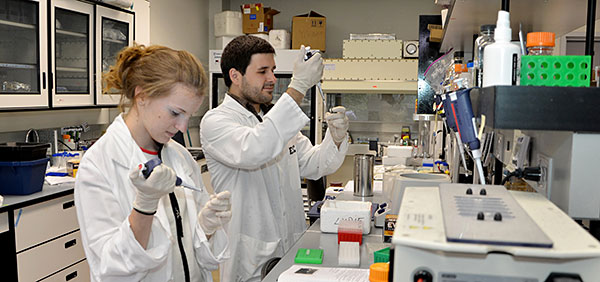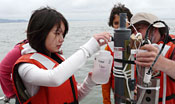You are here
High School Summer Apprenticeships 2011

CMOP hosted four high school students* during the summer of 2011 in the Apprenticeships in Science and Engineering (ASE) program. Students worked along side scientists and graduate students performing research relative to the Columbia River estuary. The center partners with Saturday Academy to offer this 8-week summer apprenticeship. Students are at CMOP from late June to the middle of August. At the end of the summer, students will present at the ASE Symposium.
INTERN PROJECTS
Environmental Chemoinformatics
Student: Jake
Mentor Paul Tratnyek
Project Description
The fundamental basis for explaining and predicting the fate of contaminants in the environment requires knowing the kinetics of all the major chemical reactions that contribute to the contaminant's degradation. For years, we have been measuring kinetic data for a variety of important contaminant degradation (and remediation) processes, and recently we have been combining our data with other data from the literature, resulting in an extensive database of kinetic data that would be profoundly useful to others. To make the data more widely available, we have been exploring ways to put the data online as a searchable database. We are open to any way of implementing this, but prefer open-source, multi-platform solutions. To be a good candidate for this work, the intern will need a strong background in chemistry and in computer technology. Some knowledge of databases, scripting languages, HTML, etc. will be essential. Preference will be given to applicants who have are currently taking or have had AP or IB level chemistry.
Remediation of Environmental Contaminants
Student: Ruby
Mentor: Paul Tratnyek
Project Description
The intern for this position will participate in research on the degradation of pollutants in the environment. In streams, sediments and groundwater, organic pollutants undergo chemical reactions that transform them into less (or sometimes more) harmful products. Understanding these degradation reactions is one of the major challenges in environmental science and engineering. The intern will participate in laboratory studies of the chemistry of contaminant remediation. This will involve measurement of organic chemical concentrations by gas and/or liquid chromatography and various types of spectroscopy. The results should help contribute to the scientific basis for regulation and remediation of environmental contamination by organic chemicals. Applicants should have completed a year of chemistry (including basic principles and laboratory techniques) by the beginning of the internship. Strong math and computer skills are also required.
Understanding Microbial Oxidation of Manganese
Student: Juyoung
Mentor: Sung-Woo Lee
Project Description
The intern selected for this position will work with researchers to understand the mechanism of microbial oxidation of manganese. Microbial manganese oxidation is considered a major process in formation of manganese oxides in natural environments. As manganese oxides can oxidize various elements and organic compounds and are thus important agents in biogeochemical cycling, it is important to understand how bacteria oxidize manganese. The ASE intern will participate in purifying and characterizing putative manganese oxidases from bacteria. Additionally, s/he will work on developing and optimizing methods for monitoring manganese in the Columbia River. Specifically, the intern will develop and optimize methods to measure soluble Mn(III), which was, until recently, considered to be only present in insoluble phases. As soluble Mn(III) can function as a diffusive oxidant, it is crucial to understand the abundance of soluble Mn(III) in the environment. As part of this job, the candidate will not only gain experience in biochemical techniques such as expression and purification of proteins from bacteria, in vitro assays looking into the mechanisms of manganese oxidation, but also operation of various analytical equipment and learning chemical assays to monitor the geochemical processes. Appropriate footwear must be worn in the lab.
Plankton Ecology in the Columbia River Estuary
Student: Deirdre
Mentor: Peter Zuber
Project Description
Each year, for at least a decade, large vivid red water blooms of the plankton Myrionecta rubra (a ciliate) have occurred in the Columbia River estuary during late summer. This organism has the unique ability to acquire chloroplasts from its prey, which are cryptophyte algae, through a process known as karyoklepty. The intern selected for this position will work with a mentor at the Center for Coastal Margin Observation & Prediction (CMOP) to use multiple genetic markers to discover genetically distinct members of Myrionecta rubra and its cryptophyte prey. Intern activities will include water sample collection throughout the estuary and the coastal ocean north of the river, nucleic acid extraction, PCR amplification, preparation of samples for cloning and sequencing and sequence data analysis. The student must wear a lab coat (provided) and closed-toe shoes while working.
* Note: CMOP does not post high school interns last name.







